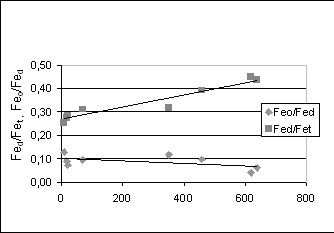
Friday, 14 July 2006
109-8
Soil Development on a Flight of Marine Terraces in Metaponto, Southern Italy.
Stephen Wagner1, Daniela Sauer1, Christine Stein1, Helmut Brückner2, and Karl Stahr1. (1) Institute of Soil Science and Land Evaluation, University of Hohenheim, Emil-Wolff-Straße 27, 70599 Stuttgart, Germany, (2) Faculty of Geography, Philipps-University Marburg, Deutschhausstraße 10, 35032 Marburg, Germany
A flight of twelve marine terraces is borgering the Gulf of Taranto. The terraces were mapped and morphologically and sedimentologically investigated by Brückner (1980). He distinguished one Holocene terrace (T0) and eleven Pleistocene terraces (T1 – T11), and assumed a subsequent formation of the terraces, starting before the Brunhes/Matuyama boundary and lasting up to the Holocene. Recently, the subsequent formation of the terraces has been questioned by Bentivenga et al. (2004). The authors interpreted the sequence as one single terrace body which had formed during the Mid Pleistocene and was later tectonically dissected so that the terrace fragments are nowadays located at different elevations above sea level. This interpretation does, however, not consider the existing chronological framework for the Metaponto terraces. Th/U datings of molluscs (Brückner, 1980) and luminescence datings of terrace sediments (Zander et al., 2003, 2006) show that the lowest Pleistocene terrace was formed during MIS 5.1. The second Pleistocene terrace (T2) could be dated to MIS 5.5 by its fossil content (Strombus bubonius). Between T5 and T6, Brückner (1980) detected an abrupt rise in weathering intensity of the terrace bodies. Terrace T8 was tephrochronologically dated to 500-600 ka BP. While terraces T0 up toT10 show the normal magnetization of the Brunhes epoch, terrace T11 was formed before the Brunhes/Matuyama boundary (i.e. before 780 ka). There is therefore strong evidence for a definite age increase from T0 up to T11. The investigation of soil development can provide additional information. It may answer the question if the terraces between the so far dated ones represent different time intervals of pedogenesis, or if some of them were later dissected. Therefore, we described and sampled seven soils on terraces T0, T1, T2, T3, T6, T7, and T9. In a first step, Fed/Fet, Feo/Fed and silt/clay ratios of the most developed horizon of each soil (Bw or Bt) were compared. The Fed/Fet ratio shows a linear increase with terrace age as estimated by Brückner (1980), indicating increasing weathering intensity, iron release from primary minerals and formation of pedogenic iron oxides. The Feo/Fed ratio shows a slight linear decrease with terrace age, indicating proceeding crystallization of iron oxides. The silt/clay ratio decreases with time, especially during the first 100 ka of soil development. These first results of the pedological studies support the interpretation of the terrace sequence as a chronosequence. Within the next few months, the results of the B horizons will be complemented by data for the whole soil profiles which shall also be presented at the conference.

Back to 1.6A Imprint of Environmental Change on Paleosols - Theater
Back to WCSS
Back to The 18th World Congress of Soil Science (July 9-15, 2006)